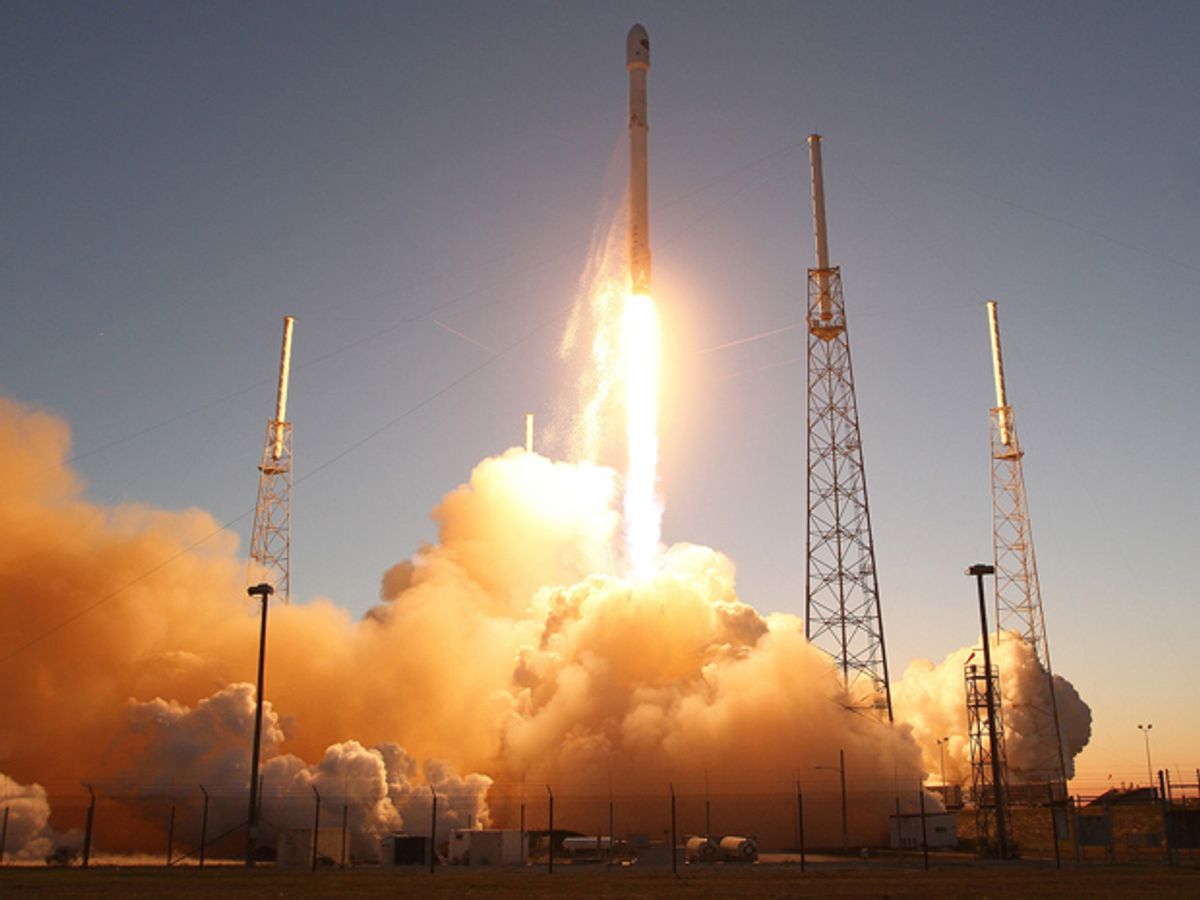Update, 12 February: The Falcon 9 rocket’s first stage pulled off a nice water splashdown despite the rough weather. “Rocket soft landed in the ocean within 10m of target & nicely vertical!” Musk tweeted. “High probability of good droneship landing in non-stormy weather.”
A huge storm forced private spaceflight firm SpaceX to cancel a pioneering demonstration of rocket science during today’s successful launch of a Falcon 9 rocket. The original plan to perform a test landing of SpaceX’s reusable rocket technology at sea was scrubbed as three-story high waves crashed over the decks of a drone ship struggling to hold its landing pad in position in the Atlantic Ocean.
Originally, the Falcon 9 rocket’s first stage would have tried for a pinpoint landing on the drone ship using rocket burns, guidance fins and four landing legs. But the extreme weather, coupled with just three of the drone ship’s four engines working, made that scenario impossible. The backup plan for the test of the Falcon 9 rocket’s return to Earth involved trying for a “soft landing” in rough seas, according to a SpaceX announcement—an action with very little probability of survival for the rocket.
“Mega storm preventing droneship from remaining on station, so rocket will try to land on water,” Elon Musk tweeted. “Survival probability <1%.”
SpaceX has made reusable rockets a key part of its goal to dramatically reduce the cost of flying to space. The private spaceflight firm points out that most launch costs currently come from building rockets designed to fly just one time. Perfecting the ability to return rockets to Earth could make the Falcon 9 heavy rockets—each costing about as much as a commercial airliner—almost as reusable as aircraft.
“If one can figure out how to effectively reuse rockets just like airplanes, the cost of access to space will be reduced by as much as a factor of a hundred,” says Elon Musk, founder and CEO of SpaceX. “A fully reusable vehicle has never been done before. That really is the fundamental breakthrough needed to revolutionize access to space.”
Getting a Falcon 9 rocket’s first stage back to Earth for a pinpoint landing aboard a drone ship at sea is no joke even in calm weather. The 14-story tall rocket stage uses hypersonic grid fins and three rocket burns to stabilize itself as it reenters the Earth’s atmosphere—a process that SpaceX has described as “trying to balance a rubber broomstick on your hand in the middle of a wind storm.” If all goes well, the rocket stage uses four landing legs to touch down upon the drone ship that serves as SpaceX’s oceangoing landing pad.
The latest Falcon 9 rocket launch was delayed from its initial scheduled launch on Sunday night because of a malfunction in the U.S. Air Force radar system being used to track the rocket during ascent, according to The Orlando Sentinel. A possible Monday launch was also pushed back because of bad weather.
SpaceX previously conducted two soft water landing tests with the Falcon 9 first stage in 2014. But the first 10 January landing attempt on the drone ship ended in a crash when the grid fins that guided the rocket’s descent ran out of hydraulic fuel just short of landing. The SpaceX team responded by upping the hydraulic fuel load by 50 percent for the latest attempt, according to Elon Musk’s Twitter account.
The second attempt to land on the drone ship will actually be much more difficult than the first because, Musk tweeted, because the rocket reentered the atmosphere following a deep space mission. That means the Falcon 9 first stage endured almost double the force and four times the heat compared with the first hard landing attempt that followed a low-orbit space station resupply mission.
The latest Falcon 9 heavy rocket launch carried a Deep Space Climate Observatory (DSCOVR) satellite designed to help monitor space weather such as potentially dangerous solar storms. Previous Falcon 9 rockets have also ferried supplies to the International Space Station. In the future, the Dragon crew capsule aboard the rockets may also carry NASA astronauts to the orbital outpost.
Falcon 9 launches currently cost about $65 million to $70 million. If SpaceX can stick the rocket landing, it could lower costs to somewhere between $30 million to $40 million, said Marco Caceres, director of space studies at the Teal Group Corporation consultancy, in a Technology Review interview.
But the SpaceX goal of eventually reducing costs by 100-fold could mean even cheaper space access. For instance, a $65 million Falcon 9 launch translates into roughly $2,240 per pound of payload for launches to low Earth orbit. A 100-fold drop in cost could mean Falcon 9 delivering payloads to low Earth orbit at a cost of just $22 per pound. (SpaceX’s even bigger Falcon Heavy rocket could theoretically drop the cost to just $10 per pound with a high enough flight rate, according to Popular Mechanics.)
Cheaper space launches could pave the way for much cheaper space missions supporting Earth-centric projects such as SpaceX’s plans to provide global Internet access through a network of satellites. They would also bring SpaceX one step closer to enabling founder Elon Musk’s dream of sending humans to colonize Mars.
Jeremy Hsu has been working as a science and technology journalist in New York City since 2008. He has written on subjects as diverse as supercomputing and wearable electronics for IEEE Spectrum. When he’s not trying to wrap his head around the latest quantum computing news for Spectrum, he also contributes to a variety of publications such as Scientific American, Discover, Popular Science, and others. He is a graduate of New York University’s Science, Health & Environmental Reporting Program.



